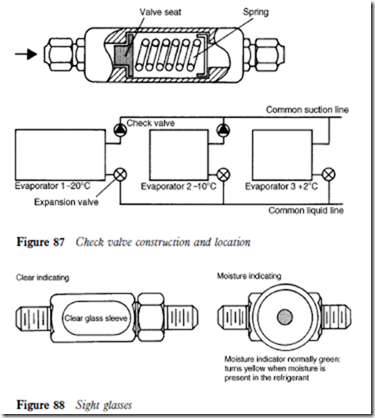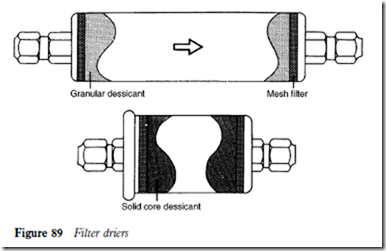Check valve
This is sometimes called a non-return valve. It is a simple device used to ensure that fluid or vapour can only travel in one direction and not back up to another part of the system pipework. Check valves have been mentioned in connection with oil separators (Figure 75), multiple evaporators (Figure 84) and hot gas defrosting (Figures 86a and 86b).
Figure 87 shows the construction of the valve, and the locations in a multiple evaporator system.
Sight glass
Two distinct types are commonly used: the clear liquid indicating, and the moisture indicating (Figure 88). Many designs are available, but the common function is to indicate levels and conditions of fluids in the system.
They should be installed close to the liquid receiver. They may be down- stream or upstream of the filter drier, but are generally upstream.
Where long liquid line runs or high liquid line risers are necessary, it is advisable to install an extra sight glass immediately before the thermostatic expansion valve. This will indicate the presence of bubbles, possibly due to pressure drop in the liquid line, thereby creating a shortage of refrigerant to the evaporator.
Filter drier
This is installed in the liquid line of the system after the receiver. Construction is generally in the form of a tube which contains coarse and fine mesh filters. These prevent foreign matter such as dirt, metal filings and carbon sludge circulating with the refrigerant. The tube also contains a drying agent or dessicant which will absorb any moisture in the refrigerant (see Figure 89).
A burn-out drier is specifically intended for installation in both the liquid line and the suction line of a system following the replacement of a hermetic or semi-hermetic compressor in which the motor windings have burnt out (see
Chapter 6). This type of filter drier has the extra ability to retain acids which could be present in the oil residue entrained in parts of the system.

